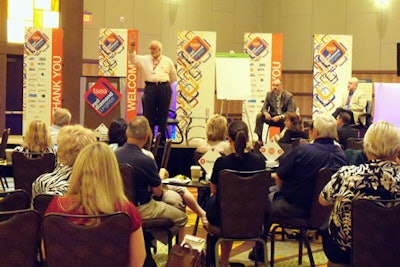
In the area of advocacy, attendees discussed the need for all industry stakeholders to work together to keep costs down. One example was encouraging show organizers to schedule trade shows so exhibitors can do their move-in and move-out on weekdays, when costs are generally lower than on weekends. Attendees also discussed their desire for more transparency in trade show costs and how those costs are passed on to exhibitors.
“Budgets are so crunched. Because we are trying to offset some of these huge costs, we are doing less in the space, we are buying smaller space, we are using lighter-weight materials that may not give the best look that we could otherwise but we are doing this because we have to reduce our expenses,” said David Burch, fleet and commercial manager of shows and exhibits for General Motors. “Then the shows end up charging more because they are selling less space. It just kind of perpetuates itself. It’s becoming critical.”
Exhibit managers shared their desire to advocate for more choices on which contractors they use at trade shows, to allow them to better control their costs and also to be more creative. In the case of some of the very large national trade shows, exhibitors are often required to use the one general contractor that is overseeing the show for all of their individual needs.
“It’s to our advantage to create and see created many, many more events of smaller size, with more targeted audiences and with a more intimate and personalized look and feel,” Hughes said.
On the topic of strategy, attendees discussed the need to promote the value of face-to-face interaction despite advancements in technology that create alternatives. Presenter Harriette Bettis-Outland, an assistant professor at the University of West Florida, said executives need to look beyond the traditional method of measuring success based on sales and leads. “We need to look at what other benefits outside of the financial do we get from trade shows?” Bettis-Outland said.
Organizers will now compile the main ideas from the conference into a report and also use them to create career development initiatives.



















